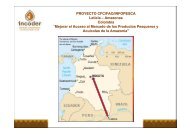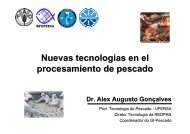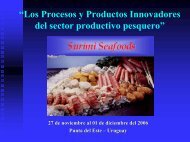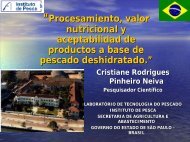o mercado de pescado da região metropolitana do rio de janeiro ...
o mercado de pescado da região metropolitana do rio de janeiro ...
o mercado de pescado da região metropolitana do rio de janeiro ...
Create successful ePaper yourself
Turn your PDF publications into a flip-book with our unique Google optimized e-Paper software.
O MERCADO DE PESCADO DA REGIÃO<br />
METROPOLITANA DO RIO DE JANEIRO, 2010<br />
IV SIMCOPE<br />
Por: Renata Melon Barroso & Alexandre Cigagna Wiefels<br />
&<br />
16ª Reunião <strong>da</strong> Re<strong>de</strong> Pan‐Americana<br />
Santos /SP<br />
Setembro, 2010<br />
renatamelonbm@yahoo.com
Projeto CFC / FSCFT / 28 :<br />
“Melhoramento <strong>do</strong> acesso aos <strong>merca<strong>do</strong></strong>s <strong>do</strong>s produtos<br />
pesqueiros e aqüícolas <strong>da</strong> Amazônia”<br />
Países: Brasil, Colômbia e Peru<br />
FIM: fortalecer a comercialização <strong>do</strong>s produtos pesqueiros<br />
e aqüícolas amazônicos fora <strong>da</strong> <strong>região</strong> amazônica.<br />
O primeiro passo está naturalmente no conhecimento <strong>do</strong>s<br />
<strong>merca<strong>do</strong></strong>s, <strong>de</strong> suas estruturas e <strong>de</strong> suas maneiras <strong>de</strong><br />
funcionar
Região Metropolitana <strong>do</strong> Rio <strong>de</strong> Janeiro:<br />
Um Centro <strong>de</strong> Consumo <strong>de</strong> 11,6 Milhões <strong>de</strong> habitantes<br />
‐ 11% <strong>do</strong> territó<strong>rio</strong><br />
Fluminense<br />
‐ 4.674,30 Km2 aos<br />
arre<strong>do</strong>res <strong>da</strong> Baía <strong>da</strong><br />
Guanabara<br />
‐ 11.634.674 habitantes<br />
(72,67% <strong>da</strong> população<br />
<strong>do</strong> Esta<strong>do</strong>)
Origem <strong>do</strong> peixe fresco consumi<strong>do</strong> no Gran<strong>de</strong> Rio<br />
• Frota fluminense: litoral<br />
capixaba ao extremo sul <strong>do</strong><br />
país<br />
• Frotas <strong>de</strong> outras regiões:<br />
Itajaí, Laguna, Rio Gran<strong>de</strong>,<br />
Belém, Espírito Santo e<br />
Bahia.
ANGRA DOS REIS<br />
85 a 90% <strong>da</strong>s capturas <strong>de</strong> sardinha‐ver<strong>da</strong><strong>de</strong>ira<br />
25% <strong>da</strong> captura <strong>do</strong>s camarões rosa, branco e<br />
sete‐barbas<br />
30% <strong>da</strong> captura <strong>de</strong> espécies <strong>de</strong>mersais, como<br />
castanha, corvina e pesca<strong>da</strong><br />
CABO FRIO<br />
15 % <strong>da</strong> produção<br />
pesca <strong>de</strong> cerco ‐ sardinha ver<strong>da</strong><strong>de</strong>ira,<br />
cavalinha, corvina, anchova, galo e<br />
xerelete.<br />
Arrasto costeiro /<br />
Pesca <strong>de</strong> linha <strong>de</strong> fun<strong>do</strong> cavala, cherne<br />
<strong>do</strong>ura<strong>do</strong>, anchova, pargo e pesca<strong>da</strong>s.<br />
Oceânica
Dinâmica <strong>de</strong> <strong>de</strong>sembarque<br />
• ATRAVESSADORES: negociação imediata com<br />
atravessa<strong>do</strong>res que <strong>de</strong>stinam os lotes <strong>de</strong><br />
<strong>pesca<strong>do</strong></strong> a caminhões frigoríficos abasteci<strong>do</strong>s<br />
<strong>de</strong> gelo em escama, transportan<strong>do</strong> o produto<br />
até os gran<strong>de</strong>s <strong>merca<strong>do</strong></strong>s atacadistas<br />
• COMERCIALIZAÇÃO DIRETA: entre o <strong>pesca<strong>do</strong></strong>r<br />
e o varejista presente no local <strong>de</strong><br />
<strong>de</strong>sembarque ocorre principalmente nas<br />
pequenas áreas <strong>de</strong> <strong>de</strong>sembarque
Dinâmica <strong>de</strong> <strong>de</strong>sembarque<br />
• carência <strong>de</strong> uma estrutura para<br />
armazenamento <strong>do</strong> <strong>pesca<strong>do</strong></strong>, os<br />
<strong>de</strong>sembarques ocorrem, em geral, <strong>de</strong><br />
acor<strong>do</strong> com a <strong>de</strong>man<strong>da</strong> <strong>do</strong> <strong>merca<strong>do</strong></strong>.<br />
• Com a redução <strong>do</strong> preço e/ou <strong>da</strong> procura<br />
<strong>do</strong> produto, o <strong>pesca<strong>do</strong></strong> fica simplesmente<br />
armazena<strong>do</strong> a bor<strong>do</strong> até a <strong>de</strong>tecção <strong>de</strong><br />
uma melhor oportuni<strong>da</strong><strong>de</strong> <strong>de</strong> negociação.
Município<br />
Niterói<br />
Rio <strong>de</strong><br />
Janeiro<br />
São Gonçalo<br />
Pontos <strong>de</strong> <strong>de</strong>sembarque<br />
PESCA ARTESANAL = 61 pontos pela orla, principalmente na baia <strong>da</strong> Guanabara.<br />
Cais Público<br />
(caracteriza<strong>do</strong> pala frota<br />
artesanal)<br />
Jurujuba<br />
Ponta <strong>da</strong> Areia<br />
Itaipú<br />
Ilha <strong>da</strong> Conceição<br />
Mantuano ou 88 (Ilha <strong>da</strong><br />
Conceição)<br />
Copacabana<br />
Pedra <strong>de</strong> Guaratiba<br />
Barra <strong>de</strong> Guaratiba<br />
Sepetiba<br />
Ramos<br />
Ilha <strong>do</strong> Governa<strong>do</strong>r<br />
Mauá<br />
Pie<strong>da</strong><strong>de</strong><br />
Suruí<br />
Associação <strong>do</strong>s Pesca<strong>do</strong>res<br />
-Gradim<br />
Cais Priva<strong>do</strong><br />
(caracteriza<strong>do</strong> pala<br />
frota industrial)<br />
Funelli (Ponta <strong>da</strong><br />
Areia)<br />
Renato (Ponta <strong>da</strong><br />
Areia)<br />
Co<strong>de</strong>pe (Ilha <strong>da</strong><br />
Conceição)<br />
Cais <strong>do</strong> Fênix<br />
Cais <strong>do</strong> Gradim (Frota artesanal)
CAIS PÚBLICOS<br />
Cais <strong>da</strong> Mantuano (Frota industrial)<br />
porão <strong>de</strong> uma traineira <strong>de</strong> long‐line no<br />
momento <strong>do</strong> <strong>de</strong>sembarque <strong>de</strong> peixes.
CAIS PARTICULARES<br />
Co<strong>de</strong>pe
Funelli / Renato
Despesca
ONDE ESTÃO AS INFORMAÇÕES ????????????<br />
O <strong>de</strong>sembarque <strong>da</strong> frota fluminense, na<br />
gran<strong>de</strong> maioria <strong>da</strong>s vezes, não possuem um<br />
controle a<strong>de</strong>qua<strong>do</strong> para gerar tais<br />
informações, ou quan<strong>do</strong> possuem, no caso<br />
<strong>do</strong>s cais particulares, não as fornecem<br />
facilmente.
Ativi<strong>da</strong><strong>de</strong><br />
Pesca<strong>do</strong> (t)<br />
2001 2002 2003 2004 2005 2006 2007<br />
Captura 64.500,5 57.725,5 53.171,5 69.510,5 64.770,0 68.140,0 85.482,5<br />
Pesca marinha 63.462,5 56.698,5 52.166,0 68.428,5 63.716,0 66.939,0 82.528,5<br />
Peixes 60.891,5 54.219,5 49.482,0 65.355,5 60.584,5<br />
Crustáceos 1.484,5 1.408,0 1.611,5 1.855,0 1.882,5<br />
Moluscos 1.086,5 1.071,0 1.072,5 1.218,0 1.249,0<br />
Pesca <strong>de</strong> Água <strong>do</strong>ce 1.038,0 1.027,0 1.005,5 1.082,0 1.054,0 1.101,0 1.046,0<br />
Peixes 1.038,0 1.027,0 1.005,5 1.082,0 1.054,0<br />
Aquicultura 5.795,0 5.884,5 7.196,5 1.704,5 2.287,5 1.908,0<br />
Águas continentais 5.786,0 5.863,0 7.176,5 1.682,5 2.259,5 29,5 1.878,0<br />
Peixes 1.677,0 1.992,0 2.116,0 1.600,5 2.188,0<br />
Crustáceos 4.005,5 3.800,0 5.000,0 20,0 21,0<br />
Anfíbios 104,0 71,0 60,5 62,0 50,5<br />
Aquicultura<br />
marinha<br />
9,0 21,5 20,0 22,0 28,0 30,0<br />
Moluscos 9,0 21,5 20,0 22,0 28,0<br />
Fonte: IBAMA
CORVINA<br />
PEIXE SAPO<br />
CONGRO<br />
PERUÁ<br />
BADEJO<br />
comercialização<br />
CHERNE<br />
GAROUPA<br />
podução<br />
A PRODUÇÃO VEM DIMINUINDO ??<br />
2007 ‐ crescimento <strong>de</strong> 23,3% na produção pesqueira <strong>do</strong> Esta<strong>do</strong> <strong>do</strong> Rio <strong>de</strong> Janeiro
CORVINA<br />
PEIXE SAPO<br />
CONGRO<br />
PERUÁ<br />
BADEJO<br />
comercialização<br />
CHERNE<br />
GAROUPA<br />
podução<br />
A PRODUÇÃO VEM DIMINUINDO ??<br />
2007 ‐ crescimento <strong>de</strong> 23,3% na produção pesqueira <strong>do</strong> Esta<strong>do</strong> <strong>do</strong> Rio <strong>de</strong> Janeiro<br />
Possibili<strong>da</strong><strong>de</strong>s:<br />
Volume <strong>de</strong> <strong>de</strong>sembarque específico<br />
Meto<strong>do</strong>logia <strong>da</strong> estatistica<br />
Aumento <strong>do</strong> consumo / <strong>de</strong>man<strong>da</strong> maior por <strong>pesca<strong>do</strong></strong>s
ESPÉCIES<br />
• SARDINHA 150 a 200 t/dia (30.000t/ano)<br />
• Corvina (espécie responsável pelo maior<br />
crescimento produção)<br />
• Cavalinha<br />
• Camarão (7 barbas, rosa, branco,barba<br />
ruça, santana, etc.)
• Salmão ‐ Chile<br />
Pesca<strong>do</strong> Cultiva<strong>do</strong><br />
• Camarão (Litopenaeus vannamei) ‐ Nor<strong>de</strong>ste, representa 70%<br />
<strong>do</strong> total <strong>de</strong> camarão comercializa<strong>do</strong> na RMRJ.<br />
(100t/semana)<br />
• tilápia in natura<br />
• Mexilhão (2t/mês)<br />
• Outros (tambaqui, pacu, trutas, bagres)
Produção <strong>de</strong> moluscos no Rio <strong>de</strong> Janeiro <strong>de</strong> 2005 a 2007 em tonela<strong>da</strong>s e<br />
preço médio (R$/kg) a primeira comercialização.<br />
Espécie<br />
Preço médio<br />
1 o comércio<br />
(R$/Kg)<br />
Total Industrial Artesanal Cultivo<br />
Lula 6,00<br />
2005<br />
558,0 451,5 106,5 0<br />
Polvo 9,80 421,0 381,5 39,0 0<br />
Mexilhão 1,00 270,0<br />
2006<br />
0,5 269,5<br />
Lula 6,00 630,0 507,5 122,5 0<br />
Polvo 9,80 521,5 476,5 45,0 0<br />
Mexilhão 1,00 318,0<br />
2007<br />
0,0 318,0<br />
Lula 6,00 645,0 572,5 72,5 0<br />
Polvo 9,80 576,0 555,5 20,5 0<br />
Mexilhão 1,00 178,5 0 166,5 12,0<br />
Ostras 8,00 3,5 0 0 3,5<br />
Vieiras 6,00 14,5 0 0 14,5
Preço<br />
Espécie médio 1 o<br />
Total Industrial Artesanal<br />
comércio<br />
(R$/Kg)<br />
Camarão-barba-ruça -<br />
2005<br />
247,0 1,5 245,5<br />
Camarão-branco - 130,0 2,5 127,5<br />
Camarão-rosa - 359,0 205,5 153,5<br />
Camarão-santana - 140,0 2,5 137,5<br />
Camarão-sete-barbas - 711,0 13,5 679,5<br />
Camarão (outras sp) - 21,5 21,5 0,0<br />
Caranguejo-uçá - 61,5 0,0 61,5<br />
Lagosta - 3,0 2,5 0,5<br />
Lagostim - 68,0 67,5 0,5<br />
Siri - 115,5 0,0 115,5<br />
Outros - 26,0<br />
2006<br />
21,0 5,0<br />
Camarão-barba-ruça 0,5 279,0 1,5 277,5<br />
Camarão-branco 12,00 142,5 2,5 140,0<br />
Camarão-rosa 13,10 360,5 209,0 151,5<br />
Camarão-santana 3,80 147,0 3,5 143,5<br />
Camarão-sete-barbas 2,80 799,5 15,0 784,5<br />
Camarão (outras sp) 2,10 18,5 18,5 0,0<br />
Caranguejo-uçá 1,00 63,5 0,0 63,5<br />
Lagosta 17,40 3,5 3,0 0,5<br />
Lagostim 7,80 63,0 62,5 0,5<br />
Siri 0,5 150,0 0,0 150,0<br />
Outros 1,00 24,5<br />
2007<br />
19,5 5,0<br />
Camarão-barba-ruça 0,5 460,0 2,5 457,5<br />
Camarão-branco 12,00 106,0 3,5 102,5<br />
Camarão-rosa 13,10 364,5 238,5 126,0<br />
Camarão-santana 3,80 75,0 5,5 69,5<br />
Camarão-sete-barbas 2,80 504,0 16,5 487,5<br />
Camarão (outras sp.) 2,10 58,5 15,5 43,0<br />
Caranguejo-uçá 1,00 93,5 0,0 93,5<br />
Lagosta 17,40 13,0 4,5 8,5<br />
Lagostim 7,80 82,5 78,0 4,5<br />
Siri 0,5 112,5 0,0 112,5<br />
Outras 1,00 73,0 23,5 49,5<br />
Crustáceos<br />
O sucesso <strong>do</strong> cultivo <strong>do</strong> camarão cinza<br />
propiciou uma gran<strong>de</strong> oferta ao <strong>merca<strong>do</strong></strong><br />
consumi<strong>do</strong>r <strong>de</strong> to<strong>do</strong> o país, com preços<br />
acessíveis pela primeira vez para um<br />
gran<strong>de</strong> número <strong>de</strong> consumi<strong>do</strong>res.<br />
O camarão cultiva<strong>do</strong> é, em geral,<br />
comercializa<strong>do</strong> “na porteira” por<br />
empresá<strong>rio</strong>s que trazem o produto ao Rio<br />
<strong>de</strong> Janeiro pela via ro<strong>do</strong>viária.
Camarão rosa (Farfantepenaeus paulensis, Farfantepenaeus brasiliensis e Farfantepenaeus subtilis)<br />
Extensa área <strong>de</strong> obtenção <strong>de</strong>sta espécie:<br />
‐ Rio <strong>de</strong> Janeiro: Janeiro a Abril<br />
‐ Rio Gran<strong>de</strong> (RS): Maio a Outubro<br />
Frota<br />
Industrial<br />
Ceasa<br />
10t/mês <strong>de</strong><br />
camarão VG.<br />
70‐80t<br />
camarão por<br />
semana
Lagosta<br />
Pesca <strong>de</strong> arrasto: Norte fluminense ao Espírito Santo<br />
As principais espécies : a lagosta sapateira ou lagostim (Scyllarus aequinoctialis) e a lagosta<br />
vermelha ou ver<strong>da</strong><strong>de</strong>ira (Panulirus argus).<br />
O <strong>de</strong>feso <strong>da</strong> lagosta, <strong>de</strong> 1o <strong>de</strong> Janeiro a 31 <strong>de</strong> Abril, parece estar surtin<strong>do</strong> efeito no aumento na<br />
produção <strong>de</strong>ste produto que em 2007 teve um crescimento <strong>de</strong> 300%
A força <strong>do</strong> <strong>merca<strong>do</strong></strong> atacadista<br />
Mantuano: Antes com 16 pregoeiros, agora só 2<br />
Colônia Z‐8: 60t/dia horá<strong>rio</strong> funcionamento: terça a <strong>do</strong>mingo, <strong>da</strong>s 03:00 e 06:00 horas <strong>da</strong> manhã<br />
Ceasa: 290t/dia (700t/dia ?) Horá<strong>rio</strong> funcionamento: segun<strong>da</strong> a sexta‐feira <strong>da</strong>s 16:00 as 23:00 h<br />
5 ‐ 20 tonela<strong>da</strong>s = média <strong>de</strong> 12,5t/box/dia<br />
56 boxes x 12,5t<br />
Apaerj 78.000t/ano x 184.800 t/ano (12,5t x 22dias x 12 meses x 56 boxes)<br />
40% <strong>do</strong> <strong>pesca<strong>do</strong></strong> fresco comercializa<strong>do</strong> no Gran<strong>de</strong> Rio
Caráter provisó<strong>rio</strong> <strong>de</strong>s<strong>de</strong> 1992<br />
Concentra a maior parte <strong>do</strong> <strong>pesca<strong>do</strong></strong> fresco
Pesca<strong>do</strong> Fresco carros‐chefe<br />
• Sardinha (50 a 60 t / dia)<br />
• Corvina (70 t / dia) chegou a representar 70% <strong>da</strong>s ven<strong>da</strong>s <strong>do</strong> CEASA<br />
em 2007<br />
• Doura<strong>do</strong> (60t / dia)<br />
• Camarão (20t / dia)<br />
• Salmão (fresco ou congela<strong>do</strong>) (2t / dia)<br />
O <strong>de</strong>stino principal (90%) <strong>do</strong> <strong>pesca<strong>do</strong></strong> comercializa<strong>do</strong> na Ceasa éo Rio <strong>de</strong> Janeiro. O restante é<br />
compra<strong>do</strong> por indústrias <strong>da</strong> <strong>região</strong> Sul e <strong>do</strong>s esta<strong>do</strong>s <strong>do</strong> Espírito Santo e <strong>da</strong> Bahia, principalmente.
CEASA ‐ Congela<strong>do</strong><br />
Proporção menor - <strong>pesca<strong>do</strong></strong> congela<strong>do</strong><br />
Principalmente pela Frescatto (5.000t <strong>de</strong><br />
congela<strong>do</strong>s/ ano) (DIPOA/MAPA).
Peixarias; 20%<br />
Outros; 3%<br />
Restaurantes;<br />
7%<br />
CEASA ‐ Clientes<br />
Super<strong>merca<strong>do</strong></strong><br />
s; 70%
Distribuição <strong>do</strong> <strong>pesca<strong>do</strong></strong> fresco<br />
Baixa<strong>da</strong> Fluminense x Zona Sul ca<strong>rio</strong>ca<br />
Maior quanti<strong>da</strong><strong>de</strong> Menos quanti<strong>da</strong><strong>de</strong><br />
Menor quali<strong>da</strong><strong>de</strong> <strong>pesca<strong>do</strong></strong>s nobres<br />
> valor <strong>de</strong> <strong>merca<strong>do</strong></strong><br />
melhor quali<strong>da</strong><strong>de</strong><br />
(mais exigentes)
29 fábricas <strong>de</strong> gelo na RMRJ<br />
A DISPONIBIDADE DE GELO<br />
A pedra <strong>de</strong> gelo <strong>de</strong> 22kg é vendi<strong>da</strong> entre R$2,50 a R$3,00.<br />
No geral, o gelo é consumi<strong>do</strong> na proporção <strong>de</strong> 1:4 (1kg <strong>de</strong><br />
gelo/4kg <strong>de</strong> peixe)<br />
No verão, a <strong>de</strong>man<strong>da</strong> por gelo por outros setores, como o<br />
comércio <strong>de</strong> bebi<strong>da</strong>s, por exemplo, leva a uma<br />
diminuição no abastecimento <strong>de</strong> gelo que chega a faltar<br />
em alguns casos.
Gran<strong>de</strong> oscilação ao longo <strong>do</strong> ano<br />
- Safras<br />
- épocas <strong>de</strong> maior consumo<br />
- Estações mais quentes<br />
- quali<strong>da</strong><strong>de</strong> <strong>do</strong> produto.<br />
Oferta x <strong>de</strong>man<strong>da</strong><br />
Preço
• ENLATAMENTO<br />
• CONGELAMENTO, inteiro ou em cortes.<br />
Pesca<strong>do</strong> conserva<strong>do</strong> / manipula<strong>do</strong><br />
• OUTROS PRODUTOS pesqueiros processa<strong>do</strong>s, numa varie<strong>da</strong><strong>de</strong> <strong>de</strong> formas <strong>de</strong><br />
conservação, apresentação e composição, como, por exemplo:<br />
– <strong>pesca<strong>do</strong></strong>s embala<strong>do</strong>s a vácuo;<br />
– produtos semi‐prontos, ten<strong>do</strong> o <strong>pesca<strong>do</strong></strong> como principal ingrediente (tortas,<br />
lasanhas, risoto, pastas, etc.);<br />
– mariscos congela<strong>do</strong>s em meia concha, <strong>de</strong>fuma<strong>do</strong>s;<br />
– linguiça;<br />
– hambúrgueres;<br />
– empana<strong>do</strong>s, entre <strong>de</strong>zenas <strong>de</strong> outras apresentações.
ENLATADOS<br />
As indústrias <strong>de</strong> conserva <strong>de</strong> sardinha e <strong>de</strong> atum <strong>do</strong> Rio <strong>de</strong> Janeiro absorvem<br />
praticamente to<strong>da</strong> a produção <strong>da</strong> frota fluminense. Comumente, tais<br />
empresas possuem acor<strong>do</strong>s e/ou contratos com os proprietá<strong>rio</strong>s <strong>da</strong>s<br />
embarcações ou com os primeiros atravessa<strong>do</strong>res.<br />
Coqueiro (Pepsico)<br />
Rubi<br />
Gomes <strong>da</strong> Costa<br />
CPC (equatoriana / entalamento brasileiro)<br />
Pesca<strong>do</strong>r (Femepe)<br />
Hayduc<br />
Ramirez (Portugal)<br />
Di Salermo (Itália)<br />
Rio <strong>de</strong> Janeiro
Consumo <strong>de</strong> enlata<strong>do</strong>s na RMRJ<br />
19.710t <strong>de</strong> sardinha<br />
4.380t <strong>de</strong> atum<br />
Equivalente “peso inteiro” em forma <strong>de</strong><br />
conserva enlata<strong>da</strong>
Consumo <strong>de</strong> enlata<strong>do</strong>s na RMRJ<br />
Participação <strong>da</strong>s versões nas ven<strong>da</strong>s<br />
em volume<br />
rala<strong>do</strong><br />
55%<br />
sóli<strong>do</strong><br />
35%<br />
pe<strong>da</strong>ços<br />
10%<br />
Participação <strong>da</strong>s diferentes versões <strong>de</strong> atum enlata<strong>do</strong><br />
Gomes <strong>da</strong> Costa no volume <strong>de</strong> ven<strong>da</strong> ‐ 2008
Importação e Exportação<br />
• EXPORTAÇÃO: 3% <strong>da</strong> exportação brasileira 11º. Lugar<br />
• IMPORTAÇÃO: 47% <strong>do</strong> total <strong>do</strong> seu consumo <strong>de</strong> <strong>pesca<strong>do</strong></strong>. 2ºLugar<br />
2009 48.700 t<br />
Principais produtos: sardinha, o bacalhau e a merluza<br />
Principais fornece<strong>do</strong>res: Marrocos, Noruega e Argentina,<br />
respectivamente.<br />
Importa<strong>do</strong> consumi<strong>do</strong> no Rio 28.000t (Estima<strong>do</strong>)
Sardinha – Marrocos / Portugal = 13.000t<br />
Bacalhau – Noruega/Espanha/China/Portugal = 7.500 t<br />
Salmão ‐ Chile (95%) = 6.860 t (US$ 34.667.308)<br />
Lembrar que no CEASA passam apenas 600t/ano<br />
Filé <strong>de</strong> merluza ‐ Argentina = 5.300t<br />
Importação Importa ão<br />
(2009)
Resumo <strong>do</strong> volume <strong>de</strong><br />
<strong>pesca<strong>do</strong></strong> Importa<strong>do</strong><br />
TONELADAS %<br />
Congela<strong>do</strong>s 31.505 64,7<br />
Salga<strong>do</strong> seco 8.562 17,6<br />
Fresco 7.940 16,3<br />
Conservas 667 1<br />
TOTAL 48.674 100<br />
(2009)
• 600t/mês<br />
• 70% origem norueguesa<br />
Portugal<br />
29%<br />
PREFERÊNCIAS DE ORIGEM NÓRDICA<br />
China<br />
1%<br />
Espanha<br />
0%<br />
Noruega<br />
70%<br />
COD (PORTO)<br />
23%<br />
TIPOS MAIS CONSUMIDOS NO<br />
BRASIL<br />
ZARBO<br />
6%<br />
LING<br />
4%<br />
SAITHE<br />
67%<br />
peixe salga<strong>do</strong> tipo bacalhau
‐ Feiras‐livres<br />
‐ Peixarias<br />
Ausência <strong>de</strong> gelo<br />
Cui<strong>da</strong><strong>do</strong> <strong>de</strong> conservação<br />
Descrição <strong>do</strong> <strong>merca<strong>do</strong></strong> varejista<br />
‐ Restaurantes e afins<br />
‐ Super<strong>merca<strong>do</strong></strong>s<br />
X<br />
atrativo e saudável<br />
ao consumi<strong>do</strong>r
Ven<strong>da</strong> <strong>de</strong> <strong>pesca<strong>do</strong></strong> fresco no <strong>merca<strong>do</strong></strong> varejista<br />
TONELADAS %<br />
Merca<strong>do</strong>s 2.850 2,1<br />
Feiras 12.291 9,2<br />
Peixarias 16.335 12,2<br />
Restaurantes e afins 24.797* 18,5<br />
Super<strong>merca<strong>do</strong></strong>s 77.867 58<br />
TOTAL 134.140 100<br />
Ven<strong>da</strong> <strong>de</strong> <strong>pesca<strong>do</strong></strong> processa<strong>do</strong> no <strong>merca<strong>do</strong></strong> varejista<br />
TONELADAS %<br />
Congela<strong>do</strong>s 29.487 36,3<br />
Importa<strong>do</strong> 27.600 34<br />
Conservas 24.090 29,7<br />
TOTAL 81.177 100
FEIRAS LIVRES<br />
Distribuição <strong>da</strong>s feiras livres <strong>do</strong> Rio <strong>de</strong> Janeiro e <strong>de</strong> Niterói<br />
(concentração nas áreas <strong>de</strong> maior <strong>de</strong>nsi<strong>da</strong><strong>de</strong> populacional)<br />
Descrição <strong>do</strong> <strong>merca<strong>do</strong></strong> varejista
diferenças sócio‐culturais <strong>da</strong>s diferentes áreas urbanas
Veículos <strong>de</strong> gran<strong>de</strong><br />
capaci<strong>da</strong><strong>de</strong> <strong>de</strong><br />
armazenamento<br />
3‐5 feirantes<br />
Armazenar lixo<br />
Manter a limpeza<br />
100 a 240 sacos <strong>de</strong> gelo<br />
por semana, a R$3,50 o<br />
saco <strong>de</strong> 20kg
peixes <strong>de</strong> água <strong>do</strong>ce secos e<br />
salga<strong>do</strong>s (Mulato Velho e o<br />
Curimatã,sardinha e<br />
camarão)<br />
CARANGUEIJO VIVO ‐ sába<strong>do</strong><br />
e <strong>do</strong>mingo chega a 10.000 ‐<br />
30.000 uni<strong>da</strong><strong>de</strong>s<br />
São Gonçalo
Rio <strong>de</strong> Janeiro - 125<br />
Niterói - 56<br />
São Gonçalo – 17<br />
150 – 400 kg <strong>de</strong> peixe / dia (275 kg/ dia)<br />
TOTAL 16.335 t / ano<br />
PEIXARIAS
• Esforço pelas peixarias em atingir a <strong>de</strong>man<strong>da</strong><br />
<strong>do</strong>s clientes, oferecen<strong>do</strong> diversos serviços<br />
como: promoções, limpeza e corte <strong>do</strong> <strong>pesca<strong>do</strong></strong>,<br />
entrega em <strong>do</strong>micílio, por vezes até temperar o<br />
<strong>pesca<strong>do</strong></strong> vendi<strong>do</strong>; tu<strong>do</strong> isso sem onerar o valor,<br />
numa estratégia <strong>de</strong> atrair o consumi<strong>do</strong>r e<br />
ganhar clientes cativos.<br />
• Dificul<strong>da</strong><strong>de</strong>s: mão-<strong>de</strong>-obra pouco prepara<strong>da</strong><br />
para a ativi<strong>da</strong><strong>de</strong>!!
Peixaria <strong>do</strong> Mercadão <strong>de</strong> Madureira
Peixaria <strong>de</strong> Alcântara, São Gonçalo
SUPERMERCADOS<br />
A ca<strong>da</strong> dia os super<strong>merca<strong>do</strong></strong>s tomam para si uma parcela maior <strong>do</strong><br />
<strong>merca<strong>do</strong></strong> <strong>de</strong> varejo, diversifican<strong>do</strong> a oferta <strong>de</strong> produtos. São<br />
pontos <strong>de</strong> referências para a compra <strong>de</strong> alimentos nas gran<strong>de</strong>s<br />
ci<strong>da</strong><strong>de</strong>s, principalmente <strong>de</strong>vi<strong>do</strong> às comodi<strong>da</strong><strong>de</strong>s apresenta<strong>da</strong>s.<br />
São responsáveis por um gran<strong>de</strong> volume <strong>de</strong> ven<strong>da</strong> <strong>de</strong> <strong>pesca<strong>do</strong></strong>, em<br />
to<strong>da</strong>s as suas apresentações (fresco, congela<strong>do</strong>, enlata<strong>do</strong> etc...).<br />
Assim sen<strong>do</strong>, o papel <strong>do</strong>s superca<strong>do</strong>s como “vitrine” para as<br />
<strong>merca<strong>do</strong></strong>rias, é evi<strong>de</strong>nte.<br />
Muitos não possuem peixarias / não têm pessoal especializa<strong>do</strong> e/ou<br />
tratamento a<strong>de</strong>qua<strong>do</strong> ao produto.<br />
a falta <strong>de</strong> cui<strong>da</strong><strong>do</strong>s a<strong>de</strong>qua<strong>do</strong>s po<strong>de</strong> aju<strong>da</strong>r a criar uma imagem<br />
ruim <strong>do</strong> produto perante os consumi<strong>do</strong>res
peixaria <strong>de</strong>ntro <strong>de</strong> um super<strong>merca<strong>do</strong></strong>
Comportamento <strong>da</strong>s ven<strong>da</strong>s <strong>de</strong> <strong>pesca<strong>do</strong></strong> durante o<br />
ano <strong>de</strong> 2009 (Janeiro a Agosto)<br />
Fonte:ASSERJ
Participação <strong>do</strong> <strong>pesca<strong>do</strong></strong> no setor <strong>de</strong> perecíveis <strong>do</strong>s<br />
super<strong>merca<strong>do</strong></strong>s<br />
Fonte:ASSERJ
Fonte:ASSERJ<br />
FATORES QUE AINDA DIFICULTAM A EXPANSÃO<br />
DA VENDA DE PESCADOS<br />
Fatores que dificultam a expansão <strong>da</strong>s<br />
ven<strong>da</strong>s <strong>de</strong> <strong>pesca<strong>do</strong></strong> nos super<strong>merca<strong>do</strong></strong>s<br />
80<br />
60<br />
40<br />
20<br />
0<br />
Alto custo <strong>de</strong> investimento nas instalações<br />
Pouca Oferta<br />
Pouca <strong>de</strong>mana<strong>da</strong><br />
O<strong>do</strong>r<br />
Gran<strong>de</strong> % <strong>de</strong> quebra<br />
Falta <strong>de</strong> pessoal especializa<strong>do</strong><br />
Descontnui<strong>da</strong><strong>de</strong> no fornecimento<br />
57,5 56 53,8 51,3 47,5 46,3 45<br />
Fatores cita<strong>do</strong>s
Espécies mais comercializa<strong>da</strong>s nos super<strong>merca<strong>do</strong></strong>s<br />
<strong>do</strong> Gran<strong>de</strong> Rio.<br />
Porcentagem<br />
20<br />
15<br />
10<br />
Fonte:ASSERJ<br />
5<br />
0<br />
14,4<br />
13,8<br />
10,4 10,4<br />
8,4<br />
Espécies<br />
4,7<br />
3,4 3,1<br />
2,8 2,5<br />
pesca<strong>da</strong><br />
sardinha<br />
camarão<br />
filé <strong>de</strong> merluza<br />
tilápia<br />
corvina<br />
cavalinha<br />
<strong>do</strong>ura<strong>do</strong><br />
tainha<br />
castanho
17%<br />
6%<br />
4%<br />
Pesca<strong>do</strong>s importa<strong>do</strong>s mais vendi<strong>do</strong>s nos<br />
super<strong>merca<strong>do</strong></strong>s <strong>do</strong> Rio <strong>de</strong> Janeiro em 2009<br />
2% 2% 1%<br />
31%<br />
Fonte: entrevistas<br />
37%<br />
merluza<br />
bacalhau<br />
salmao<br />
sardinha<br />
cação<br />
outros<br />
aba<strong>de</strong>jo<br />
pangasius
Pesca<strong>do</strong> congela<strong>do</strong> nos Super<strong>merca<strong>do</strong></strong>s <strong>do</strong><br />
Rio <strong>de</strong> Janeiro em 2009
18%<br />
Pesca<strong>do</strong> fresco comercializa<strong>do</strong>s no super<strong>merca<strong>do</strong></strong><br />
<strong>do</strong> Rio <strong>de</strong> Janeiro em 2009.<br />
9%<br />
3%<br />
2%<br />
1%<br />
67%<br />
PEIXES MARINHOS INTEIROS<br />
CRUSTÁCEOS A GRANEL<br />
PEIXES MARINHOS EM POSTA<br />
PEIXES AGUA DOCE INTEIRO<br />
PEIXES MARINHOS - FILÉ<br />
MOLUSCOS FRESCOS
PESCADOS AMAZÔNICOS E OUTRAS ESPÉCIES<br />
NATIVAS DE ÁGUA DOCE
Tilápia x truta x carpas<br />
OUTROS PEIXES DE CULTIVO<br />
ESPÉCIE / APRESENTAÇÃO VOLUME (KG)<br />
Tilápia “Saint Peter” filé congela<strong>do</strong> 11.372<br />
Tilápia – filé empana<strong>do</strong> congela<strong>do</strong> 3.978<br />
Truta – filé tempera<strong>do</strong> congela<strong>do</strong> 137<br />
Truta - filé congela<strong>do</strong> 95<br />
Truta – filé <strong>de</strong>fuma<strong>do</strong> 94<br />
TOTAL CONGELADO 15.676<br />
Carpa inteira fresca 1.997<br />
Posta carpa fresca 11<br />
Filé carpa 1<br />
Tilápia “saint Peter” - Filé fresco 19.800<br />
Tilápia “saint Peter”inteira 2.847<br />
Tilápia – filé fresco 1.511<br />
Tilápia inteira 295<br />
Tilápia limpa fresca 23<br />
Truta inteira 2.515<br />
File truta s/pele fresca 148<br />
TOTAL FRESCO 29.147<br />
TOTAL GERAL 44.823
RESTAURANTES, BARES E LANCHONETES<br />
• 198 restaurantes Frutos <strong>do</strong> mar<br />
• 176 restaurantes Cozinha oriental<br />
7.177t<br />
• 11.000 restaurantes Quilo + Outros<br />
82.657t
Ven<strong>da</strong> <strong>de</strong> Pesca<strong>do</strong><br />
Fresco – 2009<br />
TONELADAS %<br />
Merca<strong>do</strong>s 2.850 2,1<br />
Feiras 12.291 9,2<br />
Peixarias 16.335 12,2<br />
Restaurantes e afins 24.797* 18,5<br />
Super<strong>merca<strong>do</strong></strong>s 77.867 58<br />
TOTAL 134.140 100<br />
* Valor relativo a 30% <strong>do</strong> total <strong>de</strong> <strong>pesca<strong>do</strong></strong> comercializa<strong>do</strong> pelos restaurantes e afins. Os <strong>de</strong>mais 70% <strong>de</strong> <strong>pesca<strong>do</strong></strong><br />
consumi<strong>do</strong> nesses estabelecimentos são <strong>pesca<strong>do</strong></strong>s processa<strong>do</strong>s, principalmente congela<strong>do</strong>s.<br />
Ven<strong>da</strong> <strong>de</strong> Pesca<strong>do</strong> Processa<strong>do</strong> – 2009 (base inteiro)<br />
TONELADAS %<br />
Congela<strong>do</strong>s 29.487 36,3<br />
Importa<strong>do</strong> 27.600 34<br />
Conservas 24.090 29,7<br />
TOTAL 81.177 100<br />
Valores
O Consumo <strong>de</strong> Pesca<strong>do</strong> no Rio De Janeiro<br />
• 215.317 t/ano<br />
• 11.634.674 habitantes<br />
• Consumo <strong>de</strong> 18,5 kg <strong>de</strong> <strong>pesca<strong>do</strong></strong> inteiro / habitante /<br />
ano.<br />
<strong>pesca<strong>do</strong></strong><br />
processa<strong>do</strong><br />
38%<br />
<strong>pesca<strong>do</strong></strong><br />
fresco<br />
62%
O Consumo <strong>de</strong> Pesca<strong>do</strong> no Rio De Janeiro<br />
<strong>pesca<strong>do</strong></strong><br />
processa<strong>do</strong><br />
38%<br />
<strong>pesca<strong>do</strong></strong><br />
fresco<br />
62%<br />
peixarias<br />
12%<br />
feiras-livres<br />
9%<br />
restaurantes<br />
19%<br />
<strong>merca<strong>do</strong></strong>s<br />
2%<br />
Super<strong>merca<strong>do</strong></strong>s<br />
58%
PROMOÇÃO
Evolução <strong>do</strong>s Preços médios ao longo <strong>da</strong> ca<strong>de</strong>ia <strong>de</strong><br />
comercialização no Rio <strong>de</strong> Janeiro – Filé fresco<br />
(base médio) –R$/kg (outubro/2009)<br />
ESPÉCIES FEIRAS PEIXARIAS SUPERMERCADOS<br />
Ba<strong>de</strong>jo 27,00 19,90 45,00<br />
Cação 14,00 14,99 23,99<br />
Cherne 20,00 45,00 -<br />
Congro rosa - 32,00 32,39<br />
Lingua<strong>do</strong> - 27,33 23,79<br />
Namora<strong>do</strong> 13,00 - 40,00<br />
Pesca<strong>da</strong> 9,00 15,99 18,00<br />
Salmão 22,00 34,50 52,44<br />
Sardinha ver<strong>da</strong><strong>de</strong>ira 5,50 4,99 1,99<br />
Média 15,78 24,33 29,7<br />
Média comum 2 15,5 18,07 28,28<br />
1 ‐ Os preços foram calcula<strong>do</strong>s pela média entre os mínimos e máximos.<br />
2 ‐ Média calcula<strong>da</strong> apenas para os produtos com o ocorrência em to<strong>do</strong>s os segmentos <strong>da</strong> ca<strong>de</strong>ia<br />
<strong>de</strong> comercialização<br />
Fonte: Pesquisa <strong>de</strong> campo
• incremento médio <strong>de</strong> cerca <strong>de</strong> 32% entre os preços pratica<strong>do</strong>s no cais para<br />
aqueles pratica<strong>do</strong>s na Ceasa, para o <strong>pesca<strong>do</strong></strong> inteiro.<br />
• Toman<strong>do</strong>‐se a média <strong>do</strong>s preços <strong>de</strong> feiras, peixarias e super<strong>merca<strong>do</strong></strong>s (R$ 11,85),<br />
tem‐se um incremento <strong>de</strong> 111%, entre ataca<strong>do</strong> e varejo e <strong>de</strong> 179% entre o cais e o<br />
varejo.<br />
• Quan<strong>do</strong> se comparam espécies isola<strong>da</strong>s, as variações <strong>de</strong> preços são bastante<br />
diferencia<strong>da</strong>s. Por exemplo, enquanto para o <strong>do</strong>ura<strong>do</strong>, tem‐se um incremento <strong>de</strong><br />
47%, entre ataca<strong>do</strong> e varejo, para a corvina o percentual chega a 166%.<br />
• A comparação <strong>do</strong>s preços pratica<strong>do</strong>s nas feiras, peixarias e <strong>merca<strong>do</strong></strong>s e<br />
super<strong>merca<strong>do</strong></strong>s para o <strong>pesca<strong>do</strong></strong> inteiro, mostra que em média as feiras‐livres tem<br />
os valores mais baixos para o <strong>pesca<strong>do</strong></strong> fresco (R$ 10,12), segui<strong>da</strong> pelas peixarias<br />
(R$ 11,46) e super<strong>merca<strong>do</strong></strong>s (R$ 13,99).<br />
• Nos super<strong>merca<strong>do</strong></strong>s, <strong>de</strong>vi<strong>do</strong> ao alto volume <strong>de</strong> ven<strong>da</strong>, há uma chance muito maior<br />
<strong>de</strong> ocorrência <strong>de</strong> promoções e <strong>de</strong> <strong>de</strong>scontos, além <strong>de</strong> facili<strong>da</strong><strong>de</strong>s no pagamento.<br />
Ain<strong>da</strong> foi neste varejo on<strong>de</strong> a maior varie<strong>da</strong><strong>de</strong> <strong>de</strong> <strong>pesca<strong>do</strong></strong>s frescos, congela<strong>do</strong>s,<br />
enlata<strong>do</strong>s foi observa<strong>da</strong>.<br />
• Com relação ao <strong>pesca<strong>do</strong></strong> em conserva, a indústria <strong>de</strong> conserva Gomes <strong>da</strong> Costa<br />
realizou uma pesquisa <strong>de</strong> <strong>merca<strong>do</strong></strong> em 2008, observan<strong>do</strong> uma diferença<br />
percentual <strong>de</strong>clara<strong>da</strong> entre o preço <strong>de</strong> compra e o <strong>de</strong> ven<strong>da</strong> ao consumi<strong>do</strong>r <strong>de</strong><br />
35% com relação aos atuns e sardinhas enlata<strong>do</strong>s.
Volume, valor médio e valor total <strong>do</strong> <strong>pesca<strong>do</strong></strong><br />
fresco e processa<strong>do</strong> comercializa<strong>do</strong> no Rio <strong>de</strong><br />
Janeiro<br />
Pesca<strong>do</strong> Volume (t) Valor médio<br />
(US$/Kg) 1<br />
Valor total<br />
(US$)<br />
Fresco 134.140 6,27 841.057.800<br />
Processa<strong>do</strong> (base inteiro) 81.177 24,37 1.978.283.490<br />
Total 215.317 15,32 3.298.656.440<br />
* 1U$ = 1,72 R$ em Dezembro 2009<br />
1 ‐ O preço médio <strong>do</strong> <strong>pesca<strong>do</strong></strong> fresco foi obti<strong>do</strong> a partir <strong>da</strong>s médias <strong>de</strong> feiras, peixarias e<br />
super<strong>merca<strong>do</strong></strong>s (R$ 10,79 ou US$ 6,27/kg peso inteiro). Não foi feita a pon<strong>de</strong>ração,<br />
relativamente aos totais comercializa<strong>do</strong>s por espécie, na medi<strong>da</strong> em que esses números não<br />
estavam disponíveis.
Comparação <strong>do</strong>s preços <strong>de</strong> <strong>pesca<strong>do</strong></strong>s frescos ou<br />
processa<strong>do</strong>s, frango e cortes <strong>de</strong> carne bovina<br />
comercializa<strong>do</strong>s no varejo <strong>do</strong> Rio <strong>de</strong> Janeiro –R$ ‐<br />
Outubro/2009<br />
Produto Preço<br />
R$/Kg<br />
Sardinha inteira 3,50<br />
Corvina inteira 9,00<br />
Cherne inteiro 27,00<br />
Filé <strong>de</strong> merluza congela<strong>do</strong> 9,21<br />
Filé <strong>de</strong> pesca<strong>da</strong> 19,63<br />
Salmão inteiro 18,50<br />
Filé <strong>de</strong> Salmão 36,31<br />
Frango inteiro congela<strong>do</strong> 3,86<br />
Filé <strong>de</strong> peito <strong>de</strong> frango congela<strong>do</strong> 5,21<br />
Nugget frango 300 gr 3,33<br />
Patinho 10,69<br />
Contra Filé 14,46<br />
Filé mignon 28,00
Comparação <strong>do</strong>s preços <strong>de</strong> <strong>pesca<strong>do</strong></strong>s frescos ou<br />
processa<strong>do</strong>s, frango e cortes <strong>de</strong> carne bovina<br />
comercializa<strong>do</strong>s no varejo <strong>do</strong> Rio <strong>de</strong> Janeiro –R$ ‐<br />
Outubro/2009<br />
Produto Preço<br />
R$/Kg<br />
Sardinha inteira 3,50<br />
Corvina inteira 9,00<br />
Cherne inteiro 27,00<br />
Filé <strong>de</strong> merluza congela<strong>do</strong> 9,21<br />
Filé <strong>de</strong> pesca<strong>da</strong> 19,63<br />
Salmão inteiro 18,50<br />
Filé <strong>de</strong> Salmão 36,31<br />
Frango inteiro congela<strong>do</strong> 3,86<br />
Filé <strong>de</strong> peito <strong>de</strong> frango congela<strong>do</strong> 5,21<br />
Nugget frango 300 gr 3,33<br />
Patinho 10,69<br />
Contra Filé 14,46<br />
Filé mignon 28,00
Fornecimento total e per capita <strong>de</strong> <strong>pesca<strong>do</strong></strong> por<br />
continente ou por grupo econômico, em 2003.<br />
Volume (milhões <strong>de</strong> tonela<strong>da</strong>s - base<br />
inteiro)<br />
Consumo per capita<br />
(Kg)<br />
Mundial 104.1 16.5<br />
Mun<strong>do</strong> excluin<strong>do</strong> China 71.1 14.2<br />
Países Industrializa<strong>do</strong>s 27.4 29.7<br />
China 33.1 25.8<br />
Oceania 0.8 23.5<br />
Europa 14.5 19.9<br />
América Central e <strong>do</strong> Norte 9.4 18.6<br />
Países em <strong>de</strong>senvolvimento 15.8 15.5<br />
Ásia (menos a China) 36.3 14.3<br />
Economias em transição 4.3 10.6<br />
América <strong>do</strong> Sul 3.1 8.7<br />
Países pobre 23.8 8.7<br />
África 7.0 8.2
1997 2010<br />
Aumento <strong>da</strong> população14,15%<br />
consumo <strong>de</strong> <strong>pesca<strong>do</strong></strong> aumentou 28,84%<br />
16,4Kg 18,5 Kg (12,8% a mais)
acalhau<br />
norueguês<br />
1997 2010<br />
Aumento <strong>da</strong> população14,15%<br />
consumo <strong>de</strong> <strong>pesca<strong>do</strong></strong> aumentou 28,84%<br />
16,4Kg 18,5 Kg (12,8% a mais)<br />
Comercialização anual <strong>de</strong> 215.317 tonela<strong>da</strong>s<br />
<strong>merca<strong>do</strong></strong> <strong>de</strong> R$ 2,6 bilhões ao ano (preço <strong>de</strong> varejo)<br />
merluza argentina<br />
POTENCIAL NACIONAL !!!!!!!<br />
salmão<br />
chileno
“O RJ éum <strong>merca<strong>do</strong></strong> em<br />
potencial on<strong>de</strong> tu<strong>do</strong> se<br />
By Francesco Franco<br />
ven<strong>de</strong>”.
• IBAMA<br />
• MARA (Lucio Kikuchi, Mauricio Raposo, Manuel)<br />
• MPA (Abraão Oliveira, Nei<strong>de</strong> Clea)<br />
• ABRAS (Marcos Manéa)<br />
• ASSERJ<br />
• Grupo Pão <strong>de</strong> Açúcar (Meg Felippe)<br />
• ASPERJ - CEASA(Francesco)<br />
• SAPERJ (Alexandre)<br />
• Pepsico (Celestino Caetano)<br />
• Rubi<br />
• Abrasel (Rodrigo Gue<strong>de</strong>s)<br />
Agra<strong>de</strong>cimento<br />
Obriga<strong>da</strong> !!!








